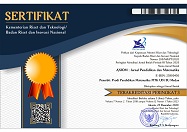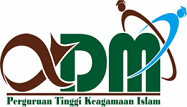PENINGKATAN KEPERCAYAAN DIRI SISWA SMP DENGAN PEMBELAJARAN KOOPERATIF TIPE THINK PAIR SQUARE
Abstract
Abstrak:
Kepercayaan diri siswa menjadi hal yang penting dalam mempersiapkan siswa menghadapi kehidupan yang semakin menantang. Salah satu metode yang dapat digunakan untuk meningkatkan kepercayaan diri siswa adalah pembelajaran kooperatif tipe Think Pair Square (TPS). Pembelajaran kooperatif tipe TPS adalah model pembelajaran kelompok heterogen yang memberikan kesempatan kepada siswa untuk berpikir mandiri kemudian mendiskusikan hasil pemikirannya dengan pasangan berdua dan berempat. Dalam meningkatkan kepercayaan diri siswa ini dilakukan penelitian tindakan kelas menggunakan pembelajaran kooperatif tipe TPS untuk siswa SMP. Selama Oktober hingga Desember 2018 penelitian dilakukan sebanyak dua siklus dan diterapkan kepada 32 siswa SMP di Pekanbaru. Data penelitian diperoleh dari instrumen non tes yaitu angket kepercayaan diri, lembar pengamatan guru dan siswa, catatan peneliti, dan lembar refleksi. Kondisi awal menunjukkan rata-rata kepercayaan diri siswa berada pada kriteria sedang. Setelah siklus 1 diperoleh rata-rata kepercayaan diri siswa meningkat menjadi kriteria tinggi, namun masih terdapat beberapa catatan yang ditulis dalam lembar refleksi. Setelah adanya perbaikan, rata-rata kepercayaan diri siswa berada pada kriteria tinggi dengan nilai rata-rata yang meningkat dibanding siklus 1 dikarenakan adanya upaya perbaikan yang disesuaikan dengan rencana. Hal ini memperlihatkan bahwa target peningkatan kepercayaan diri siswa SMP tercapai melalui pembelajaran kooperatif tipe TPS, dengan kondisi siswa berada pada kelas VIII dengan kelas yang heterogen dan kemampuan kognitif siswa rata-rata berada pada kategori sedang.
Kata Kunci:
Kepercayaan Diri, Pembelajaran Kooperatif, Think Pair Square.
Abstract:
Student confidence is important in preparing students for increasingly challenging lives. One method that can be used to improve student confidence is Think Pair Square (TPS) cooperative learning. TPS type cooperative learning is a heterogeneous group learning model that provides opportunities for students to think independently then discuss the results of their thinking with partners of two and four. In increasing students' confidence, a classroom action research study using TPS cooperative learning for junior high school students was conducted. During October to December 2018 the study was conducted in two cycles and applied to 32 junior high school students in Pekanbaru. The research data were obtained from non-test instruments namely self-confidence questionnaire, teacher and student observation sheets, researcher notes, and reflection sheets. The initial conditions indicate the average level of student confidence is at the medium criteria. After cycle 1, the average student's self-confidence is increased to a high criterion, but there are still some notes written in the reflection sheet. After the improvement, the average student confidence is at a high criterion with an average value that increases compared to cycle 1 due to the improvement effort that is adjusted to the plan. This shows that the target of increasing the confidence of junior high school students is achieved through cooperative learning type TPS, with the condition of students in class VIII with heterogeneous classes and cognitive abilities of students in the average category is in the medium category.
Keywords:
Self Confidence, Cooperative Learning, Think Pair Square
Full Text:
PDF (Indonesian)References
Adywibowo, L.P. (2010). Memperkuat kepercayaan diri anak melalui percakapan referensial. Jurnal Pendidikan Penabur No. 15/Tahun ke-9/Desember 2010. Jakarta: Prenada Media Group.
Aisah, S., Ashari, H., & Akhdinirwanto, R.W. (2013). Penggunaan model pembelajaran cooperative learning tipe think pair square berbantuan kartu soal untuk meningkatkan aktivitas belajar siswa kelas VII b SMP Negeri 5 Purworejo. Abstrak Hasil Penelitian Universitas Muhammadiyah Purworejo. Purworejo
Arends, R.L., & Kilcher, A. (2010). Teaching for student learning becoming an accomplished teacher. New York: Routledge.
Brockbank, A., & McGill, I. (2007).Facilitating reflective learning in higher education. London: Mc-Graw Hill.
Depdiknas. 2003. Permendiknas No 20/2003: Sistem pendidikan nasional. Jakarta: BSNP.
Goel, M. & Aggarwal, P. (2012). A comparative study of self confident of single child and child with sibling. International Journal Research in Social Sciences, 2, 89-98.
Hamalik, Oemar. (2007). Proses belajar mengajar. Jakarta: Bumi Aksara.
Hannula, M.S., Maijala, H., & Pehkonen, E. (2004). Development of understanding self-confidence in mathematics grades 5-8. Group for the Psychology of Mathematics Education. 3, 17-24.
Haylock, D. & Tangatha, F. (2007). Key concept in teaching primary mathematics. London, UK: Sage Publication.
Hebaish, SM. (2012). The correlation between generalself-confidence and academic achievement in the oralpresentation course. Theory and Practice in Language Studies. 2(1), 60- 65.
Hendriana, Heris. (2012). Pembelajaran matematika humanis dengan metaphorical thinking untuk meningkatkan kepercayaan diri siswa. Jurnal Ilmiah. 1(1).
Ibrahim, M., Rachmadiarti, F., Nur, M., & Ismono. (2001). Pembelajaran kooperatif. Surabaya: UNESA – University Press.
JIST Live. (2006). Young person’s caracter education handbook. Indianapolis, IN: JIST Publishing, Inc.
Kemendikbud. (2013). Permendikbud no 65/2013: Standar proses pendidikan dasar dan menengah. BSNP. Jakarta
Kemp, J.E., Morisson, G., & Ross, S.M. (1985). Designing effective instruction. New York: Macmillan College Publishing Company.
Lie, Anita. (2008). Cooperative learning: Mempraktikkan cooperative learning di ruang-ruang kelas. Jakarta: Grasindo.
NCTM. (2000). Principles and standards for school mathematics. Reston: National Concil of Teacher of Mathematics.
Nitko, A.J. & Brookhart, S.M. (2011). Educational asessment of student. Boston: Pearson Education.
Orlich, et al. (2007). Teaching strategies a guide to effective instruction. Boston: Houghton Mifflin Company.
Sanjaya, Wina. (2010). Perencanaan dan desain sistem pembelajaran. Jakarta: Kencana.
Scunk, D.H. (2012). Learning theories: An educational perspective. Boston, MA: Pearson Education.
Slavin, Robert E. (2005). Cooperative learning: Theory, research, and practice. Boston: Ally and Bacon.
Srivastava, S.K. (2013). To study the effect of academic achievement on the level of self confident. J. Psychosoc. Res., 8(1), 41-51.
Suherman, E., dkk. (2003). Ragam metode mengajar eksata pada murid. Yogyakarta: DIVA Press.
Susanti, Martina. (2010). Meningkatkan motivasi, aktivitas, dan hasil belajar siswa kelas X animasi 2 SMK Negeri 11 Semarang pada materi bilangan riil melalui pembelajaran kooperatif kombinasi STAD-TGT berbantuan media CD pembelajaran. Abstrak Skripsi. Universitas Negeri Semarang
Syaifullah, Ach. (2010). Tips bisa percaya diri. Jakarta: Gara Ilmu.
Trianto. (2011). Mendesain model pembelajaran inovatif-progresif: Konsep, landasan, dan implementasinya pada kurikulum tingkat satuan pendidikan (KTSP). Jakarta: Prestasi Pustaka.
Uno, H.B. (2008). Teori motivasi dan pengukurannya. Jakarta: Bumi Aksara.
Van De Walle, J.A. (2007). Sekolah dasar dan menengah matematika pengembagan dan pengajaran. Jakarta: Erlangga.
Yoder, J. & Proctor, W. (1988). The self-confident child. New York, NY:Fact on File Publication.
Young, Michael. (2015). What is learning and why does it matter?. European Journal of Education, 50(4), 524.
DOI: http://dx.doi.org/10.30821/axiom.v9i1.7267
Refbacks
- There are currently no refbacks.
Copyright (c) 2020 Fitria Mardika, Rusi Ulfa Hasanah

This work is licensed under a Creative Commons Attribution-ShareAlike 4.0 International License.
p-ISSN: 2087-8249 | e-ISSN: 2580-0450
Indexed by:
AXIOM : Jurnal Pendidikan dan Matematika is licensed under a Creative Commons Attribution-ShareAlike 4.0 International License.











